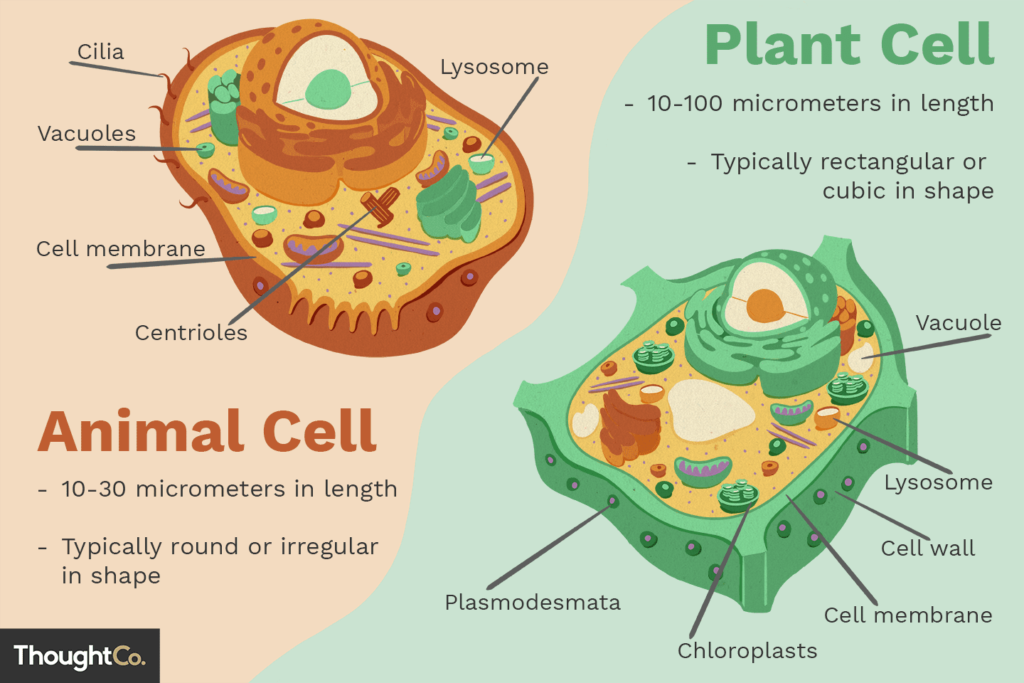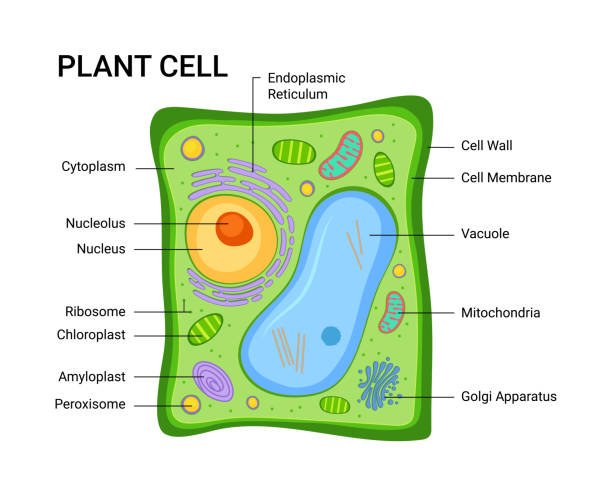Difference Between Plant Cell and Animal Cell for Class 9:
For a class 9 student, understanding the difference between plant cells and animal cells is fundamental in biology. Here are the key differences in a simple and concise manner:
- Cell Wall: Plant cells have a rigid cell wall made of cellulose that surrounds the cell membrane. This cell wall provides structure, support, and protection. Animal cells do not have a cell wall; they only have a cell membrane which is more flexible.
- Chloroplasts: Plant cells contain chloroplasts, which are the sites of photosynthesis. Chloroplasts contain chlorophyll, the green pigment that captures light energy to convert water and carbon dioxide into oxygen and glucose. Animal cells do not have chloroplasts as they do not perform photosynthesis.
- Vacuoles: Both plant and animal cells have vacuoles, but plant cells typically have one large central vacuole that occupies most of the cell’s volume. This vacuole stores water, nutrients, and waste products and helps maintain turgidity in the cell. Animal cells may have small vacuoles, but they are much smaller and less prominent.
- Shape and Size: Plant cells generally have a rectangular shape due to the rigid cell wall, making them appear more structured and regular. Animal cells have a more rounded or irregular shape due to the lack of a cell wall, allowing for more flexibility.
- Lysosomes: Lysosomes are more commonly found in animal cells. They are organelles filled with enzymes that can break down cellular waste and debris. While plant cells can have lysosomes, they are less common and plants often use other organelles, like the vacuole, for similar functions.
- Centrioles: Centrioles are present in animal cells and play a crucial role in cell division, helping to organize the mitotic spindle. Plant cells do not have centrioles; they use other structures to organize their chromosomes during cell division.

Understanding these differences helps highlight how plant and animal cells are specialized to perform their unique functions in their respective organisms.
Here’s a comparison between plant cells and animal cells in a table format suitable for a class 9 level:
| Feature | Plant Cell | Animal Cell |
|---|---|---|
| Shape | Usually rectangular | Usually round or irregular |
| Cell Wall | Present, made of cellulose | Absent |
| Chloroplasts | Present, contain chlorophyll for photosynthesis | Absent |
| Vacuoles | Large central vacuole, storing water and other substances | Small and numerous, if present |
| Centrioles | Absent (except in some lower plants) | Present, involved in cell division |
| Lysosomes | Rarely present | Commonly present |
| Cytoplasm | Pushed to the cell periphery by the central vacuole | Fills the cell |
| Plastids | Present, including chloroplasts, chromoplasts, and leucoplasts | Absent |
| Energy Storage | Starch | Glycogen |
| Cytokinesis | Occurs by cell plate formation | Occurs by cleavage furrow |
This table highlights the key differences between plant and animal cells, which are fundamental to understanding their distinct functions and roles in the biological world.
Key Terminologies
In terms of understanding the difference between plant cell and animal cell, here’s a list of relevant terminologies commonly associated with plant cells and animal cells, which will help deepen the understanding of their structure and function:
Plant Cell Terminologies:
- Cell Wall: A rigid layer that surrounds the plant cell, providing structural support and protection.
- Chloroplasts: Organelles that contain chlorophyll and carry out photosynthesis, converting light energy into chemical energy.
- Central Vacuole: A large, water-filled organelle that helps maintain cell turgor pressure, supports cellular structure, and stores nutrients and waste products.
- Plastids: Organelles involved in the synthesis and storage of food, including chloroplasts (photosynthesis), chromoplasts (pigment synthesis and storage), and leucoplasts (starch storage).
- Cellulose: A polysaccharide that is a main component of the plant cell wall.
- Plasmodesmata: Channels through the cell walls that allow communication and transport between plant cells.
Animal Cell Terminologies:
- Centrioles: Cylindrical structures that play a crucial role in cell division by facilitating the formation of the mitotic spindle.
- Lysosomes: Organelles containing digestive enzymes that break down waste materials and cellular debris.
- Cleavage Furrow: The indentation that appears in the cell’s surface when an animal cell is about to divide; it deepens until the cell is pinched into two separate cells.
- Glycogen: A multi-branched polysaccharide that serves as a form of energy storage in animal cells.
- Cytokinesis: The process during cell division in which the cytoplasm of a single eukaryotic cell divides to form two daughter cells.
- Membrane-bound Organelles: Organelles in animal cells, such as the nucleus, endoplasmic reticulum, Golgi apparatus, lysosomes, and mitochondria, that are enclosed by membranes.
These terminologies highlight the distinct features and functions of plant and animal cells, contributing to their unique roles in their respective organisms.
Why Understanding the Difference Matters
Understanding the difference between plant cells and animal cells is crucial for several reasons, especially for class 9 students who are at a foundational stage in their science education. Here’s why these differences matter:
- Foundation for Biology: Recognizing the distinctions between plant and animal cells lays the groundwork for understanding more complex biological concepts. It helps students grasp the diversity of life and the specialization of cells according to their roles in different organisms.
- Functional Insights: The differences between these cells reflect their unique functions. For example, chloroplasts in plant cells are essential for photosynthesis, a process that doesn’t occur in animal cells. This distinction is fundamental to understanding how energy flows through ecosystems, with plants acting as producers.
- Structural Adaptations: The presence of a cell wall in plant cells but not in animal cells highlights how structures are adapted to function. The rigid cell wall allows plants to stand upright and reach for sunlight, which is vital for photosynthesis, whereas the flexibility of animal cells facilitates a variety of movements and interactions within an organism.
- Health and Medicine: Understanding animal cell structures is critical in medical science, especially for disease diagnosis and the development of treatments. Knowledge of how animal cells function, and how they differ from plant cells, underpins much of the research into human diseases and their treatments.
- Biotechnology Applications: Knowledge of the differences between plant and animal cells is essential in biotechnology, where both types of cells may be manipulated for the production of food, drugs, and other products. For example, genetic engineering in plant cells can lead to crops that are more nutritious or resistant to pests and diseases.
- Educational Progression: For class 9 students, distinguishing between plant and animal cells is a stepping stone to more advanced topics in biology, such as genetics, ecology, and physiology. A solid understanding of cell biology is crucial for any further study in the life sciences.
- Critical Thinking and Observation Skills: Learning to identify and understand the differences between plant and animal cells helps develop students’ observation and critical thinking skills. It encourages analytical thinking and the ability to make distinctions based on observed characteristics.
In summary, the differences between plant and animal cells are not just fundamental biological facts; they are essential for a comprehensive understanding of life sciences. They serve as a basis for exploring a wide range of biological phenomena, from the molecular level to ecosystems, and have practical implications in health, agriculture, and biotechnology.

